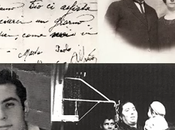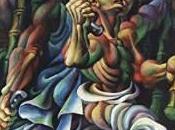I just came back from the conference organised by the Australasian Association for Literature at Monash University, Caulfield, and I thought some people might like a quick report. This year the theme was Literature and Translation, and I decided to submit an abstract, to see whether my slightly academic foray at the Sydney Symposium was just a fluke or not. Surprisingly (as I am just a humble practitioner, and not a university-based scholar), my abstract was accepted and I presented a paper titled Translation as Re-creation, which I will probably publish on this blog in the coming weeks.
 The conference was impeccably organised, the hosts were lovely, and there was an abundance of interesting ideas going around the H building of the Caulfield campus. First of all, we had the privilege of listening to a fantastic keynote speech by comparative literature star David Damrosch, author of What is World Literature? and a major player shaping the future of his field of studies. His unassuming, modest attitude is really refreshing, if we consider that he studied at Yale and is Chair of Comparative Literature at Harvard. He is able to illustrate the complexities of world literature with surprising zest, brilliantly conveying his evident passion and love for literature. He can talk about The Epic of Gilgamesh, throw in a reference to Aztec texts, and then proceed to put on a playful but impeccable Russian accent when reading out the fictional author Vladimir Brusiloff’s lines from “The Clicking of Cuthbert”, a short story by P. G. Wodehouse. Hard to follow that, let me tell you.
The conference was impeccably organised, the hosts were lovely, and there was an abundance of interesting ideas going around the H building of the Caulfield campus. First of all, we had the privilege of listening to a fantastic keynote speech by comparative literature star David Damrosch, author of What is World Literature? and a major player shaping the future of his field of studies. His unassuming, modest attitude is really refreshing, if we consider that he studied at Yale and is Chair of Comparative Literature at Harvard. He is able to illustrate the complexities of world literature with surprising zest, brilliantly conveying his evident passion and love for literature. He can talk about The Epic of Gilgamesh, throw in a reference to Aztec texts, and then proceed to put on a playful but impeccable Russian accent when reading out the fictional author Vladimir Brusiloff’s lines from “The Clicking of Cuthbert”, a short story by P. G. Wodehouse. Hard to follow that, let me tell you.
Unfortunately, for the rest of the conference we had five or six parallel sessions running at any given time, so I missed out on a number of promising papers.
The first session I attended was titled The Translation Process. I very much enjoyed Marc Orlando‘s reflections on his French translation of Mau Moko, an English/Maori book about the art of face tattooing in Polynesian history, imbued with a political activism which proved challenging in the translation process (yes, intents have to be translated too). His use of music (four different arrangements of La valse d’Amelie) to show how the same work can be arranged differently depending on intents, context, and audience also echoes one of the points I made in my own paper, namely “if anyone performing a cover or a rendition of a classical piece is considered a musician, why should the translator not be considered a writer?” Moreover, I appreciated his very pragmatic and contemporary approach to the problem of foreignisation (i.e. “leaving the author alone and moving the reader towards the author”) and domestication (“leaving the reader alone and moving the author towards the reader”) that leads to the identification of the translator’s space, a no-man land in between the two poles, where the author and the reader should meet. Again, I made a similar point in my paper in Sydney when warning about the excessive adherence to theoretical poles. After him the flamboyant Royall Tyler delivered an illuminating lecture on translating medieval Japanese epics, complete with a popular rendition of traditional japanese music and poetry.
On the Censorship and Ideology panel, Belinda Calderone illustrated how translations of 16th and 17th century Italian and French fables in Victorian England sanitized and censored the text to the point of incoherence and inconsistency, eliminating themes like violence, abuse, rape, and murder while trying to turn what were essentially folk tales into children stories. Feng Cui, in absentia, contributed an interesting paper about the role of state-sponsored translations shaped the literary discourse in communist China to serve the shifting political agenda from the late 1940s until the Cultural Revolution and beyond.
In Translating Style and Voice, Leah Gerber faced the complex issue of aging translations with a detailed study of Erich Kästner’s Emil und die Detektive in its various English translation, opening up room for debate. Why do translations age? Should we re-translate a work from the 1920s to make it sound more contemporary and ensure the work will still be read? And has the original aged with the translation? If not, can we find a translation strategy that will enable the text to stand the test of time without making Emil sound like a modern boy? After her, Suzie Gibson delivered a nice reading of the countless adaptations of James’s The Turn of the Screw, followed by Andrew Read‘s excellent presentation which looked at Pullman’s Northern Lights and its French and German translations as well as stage and film adaptation, in order to analyse the consequences of the translator’s choices on the work. In the original, Lyra, the main character, speaks a distinctive working class sociolect that is rendered very effectively with non-standard spelling and grammar. All translations (and, to a certain extent, the film adaptation) flatten this out, assigning Lyra much more correct speech patterns that not only change the perception of the character, but actually influence the perception of the relationships between characters. Once again, that’s another point I made elsewhere, and it’s hard to overstate how crucial this can be for the outcome of a translation.
On Tuesday, the panel Cross-fertilisation and transmission sounded very promising, and was quite interesting, too. Emily Finley’s paper focused on the issue of translating the Hegelian term Aufheben (a word connoting simultaneous destruction and preservation). How to translate it: suppress? Abolish? Remove? The odd sublate? Or maybe, as someone from the audience suggested, with take care of? Chris Danta‘s paper was very insightful but very much removed from translation issues. When he used the word translation he did not mean what we commonly understand it to mean. I am pretty sure that anyone who is active in literary scholarship would have found the paper very well-written, and I could definitely see its originality. It’s just that it was quite out of my domain as a translator. The panel also included Slobodanka Vladiv-Glover, who analysed Bakhtin’s model of parody as a means of transmission (and translation) of cultural forms, underlining how translation itself can lead to the establishment of new literary genres in national spaces where they previously absent.
Then, tension beginning to rise in anticipation of my presentation, it was time for Creation and creativity (I). Curiously enough, as I was on Creation and creativity (II) just after lunch, I was quite disappointed by two of the speakers on this panel. It actually started very well, with Joel Scott and his very compelling arguments about “difference” in writing and translating. Joel had some interesting ideas on the role of difference, including language difference, in literature. I would have loved to hear more about the possible translation process he envisions for Susana Chàvez Silverman’s bilingual writing, and less about the socio-political, post-colonial implications of difference, but all in all it was a very enjoyable paper and I found myself nodding in approval at several of Joel’s statements. The next presenter, Luke Johnson, focused instead on how authors recognise themselves in their work and in the translating text, with and very thought-provoking psychological parallels with infants learning to recognise themselves in a mirror. It was mostly very theoretical, though, and not really concerned with translation. Plus, he totally lost me when he likened the translator to someone taking a picture. Anyone who has ever translated a paragraph should know it takes a bit longer than a click. Maybe if he replaced that with a hyper-realist painter. That’s more like it, I’d say. After him, H.J. van Leeuwen circled around the issue of translation with fairly textbook quotes and a lot of philosophical reflection. I could see he was certainly competent in his field, and despite his initial disclaimer “I’m not a translator” I couldn’t help but thinking it was mostly a lot of philosophical fluff. Please note, I’m not slamming anyone, here. Even the two last speakers clearly knew what they were doing. It’s just that neither of the papers was dealing with the translation process in an engaging way. I am extremely interested in translation theories and studies but only as long as the theory is there to inform the practice, shed light on it. When translation as a whole, instead, becomes one of many examples to use in a discourse that is not concerned with translation, my interest starts to waver, unless I am listening to a David Damrosch.
The last panel, which included yours truly – yeah, no chance to relax until the very end – was, fortunately for me, a quite different story. Emiko Okayama, translator and scholar, used her very attentive research to show how different translations and subsequent adaptations of the Chinese vernacular novel Suikoden into Japanese not only ended up generating an original Japanese work (Nansō Satomi Hakkenden) but, again, gave rise to a new genre in Japanese literature. The other speaker, Nataša Karanfilović, conducted a thorough research to expose what I called “the dark side of re-creation”, showing how a score of gross mistakes in the translation of Patrick White’s The Aunt’s Story not only obliterated countless cultural references, but made for an incoherent text whose poor reception basically sabotaged White’s appeal on the Serbian market, where no other novels of his have been translated after this fiasco. As for yours truly, waiting for a polished version of the paper (and especially waiting for its not-yet-existent Italian translation) I will share my abstract in the hope of enticing readers:
Translation as Re-creation
Is the translator a writer? Technically speaking, it would seem obvious. Yet, the perception is often very different. If performing a cover, or a rendition of a classical piece, makes one a musician, why should not the translator be considered a writer? One might say that translators are not creative writers but, of course, even that is not true, as any translation constantly requires linguistically and culturally creative solutions. Too many people, even in the publishing industry, have the perception that texts exist as unchanging entities, and that the language they are written in is but a patina that can be almost mechanically scrubbed away and replaced. What are the dangers of this misconception? Translators are writers who creatively manipulate the linguistic and cultural elements of a text to produce a new, original text, of which they are legally recognised as the authors. What’s more, the very act of translating into a different language inevitably influences the tone and style of the narration, even the voices of the characters. This paper will move from these issues to explore the idea of translation as re-creation, in both its senses of “creating anew” and “refreshment of strength and spirits” or “diversion,” focusing on the regenerative powers of translation on texts and languages, as well as on translators and readers.
Then we had the privilege to go back to the main lecture theatre to listen to Rita Wilson, Brian Nelson and David Damrosch discussing translation and world literature, another fantastic set of speakers for a great finale.
Unfortunately, there were many papers I missed which I would have loved to listen to. Laura Olcelli’s paper about “geographical and linguistic disorientation”, Felix Siddel’s presentation about Buzzati and “translation as a catalyst in a literary career”, Maria Cristina Seccia’s paper Translating Caterina Edwards: the overlap of two cultures, Luigi Gussago’s presentation about Cesare De Marchi and many more.
The good thing, though, it’s that this conference had the precise aim of “educating” the academy about the importance of translation, and judging by the amount of academics present (I was probably the only one who was not and never had been affiliated to a university) it looks like it certainly did it what it wanted to do. Translation seems to be oddly fashionable in academic circles at the moment, and I urge all translators to strike the hammer while the iron is hot and contribute whatever they can contribute so we can finally give literary translation its rightful place in literary and cultural studies.
Tagged: AAL Conference 2011, Brian Nelson, David Damrosch, Literary Translation, Rita Wilson, Translation







